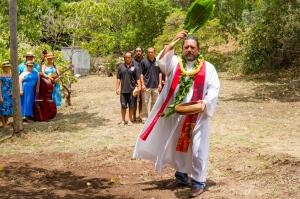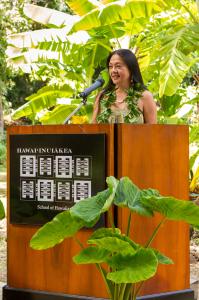Groundbreaking held for Kanewai Cultural Resource Center
University of Hawaiʻi at MānoaPhotos, video and sound are available for this story. See information at the bottom of this News release.
Ka Papa Loʻi ʻO Kānewai Cultural Garden at the UH Mānoa campus held a groundbreaking ceremony today, Tuesday, August 20, for its new Cultural Resource Center on Dole Street next to the Kamakakūokalani Center for Hawaiian Studies, Hawai‘inuiākea School of Hawaiian Knowledge.
Kānewai successfully secured a $670,000 grant from the U.S. Department of Housing and Urban Development (HUD) to build a 2,325-foot, ADA-compliant, multi-purpose facility to include a large resource room and community learning area, an adjoining meeting room, learning laboratory, workshop, storage space and restrooms.
“We are excited and ready to go,” said Edward Makahiapo Cashman, Kānewai’s executive director. “We’ve managed to run undergraduate courses and hold classes and programs here without any kind of facility for decades. Last year, we had just under 30,000 people come through.”
Kānewai is a 3.5-acre oasis of gurgling streams, taro ponds, native plant gardens, handmade rock terraces, and a single traditional, open-sided, thatched A-frame structure. It is bordered by the Hawaiian Studies complex, towering student dorms, and the non-stop rush of cars on Dole Street.
“Kānewai is one of the last agricultural terraces in a network that once connected Mānoa to Waikīkī. Its last commercial use was for rice farming all the way into the 1970s,” says Cashman. Then, in the 1980s, several UH Mānoa students uncovered the area’s defunct water ditch system. Led by kupuna Harry Mitchell, they began to restore the kalo terraces and irrigation system.
Since then Kānewai has become a “seed bank” of over sixty varieties of native kalo, all non-GMO, and free of disease, viruses and vermin. It is thought to be the largest collection of native Hawaiian varieties in existence.
“We have students, farmers, families, community organizations, university departments, schools, and individuals come to learn and teach seven days a week,” explains Cashman about the wildly popular outdoor classroom. “Having a modest structure will allow us to host more students and volunteers and better leverage the curriculum and programs we’ve developed over the years.”
In addition to the federal HUD grant, Kānewai held fundraisers and won support from a small group of key donors including the Abigail K. Kawananakoa Foundation, the Gladys Kamakakūokalani ʻAinoa Brandt Endowed Chair, the Consuelo Foundation, Virginia Hinshaw, and the Judith D. Pyle Dean's Chair. Design and engineering work was contributed at no cost by Rob Iopa of WCIT with the help of the UH Mānoa School of Architecture. Cashman says, “The center was actually designed using traditional Hawaiian measurements.” The plans conform to building code and the result, says Cashman, will be a place that “reflects the significance of kalo to the Hawaiian people.”
About Ka Papa Loʻi ʻO Kānewai
Established in 1980, Kānewai is the most experienced teaching cultural garden in Oceania and guardian of most varieties of Native Hawaiian taro. Kānewai operates as an educational center with the full support and standing of the University of Hawai‘i and Hawai‘inuiākea School of Hawaiian Knowledge, the largest and only indigenous college in a Research I University. Kānewai is located at 2645 Dole Street in Honolulu. Open seven days a week, all are welcome and admission is free.
PHOTOS, VIDEO AND SOUND AVAILABLE:
Link to the download video and sound: http://bit.ly/16u76zC
Link to photos: http://www.flickr.com/photos/uhmanoa
BROLL (1 minute, 9 seconds):
- Ceremony including Oʻo sticks (4 shots)
- Kānewai loʻi patches (3 shots)
- Students working in loʻi patch (3 shots)
SOUNDBITES:
Edward Makahiapo Cashman – Executive Director, Ka Papa Loʻi Kānawai Cultural Garden (15 seconds)
“It will bring us from out under the tents into a nicer facility. And again, the facility doesn’t really tell us what to do, so we get to have workshops, we get to have meetings, we get to have classes, and then serve the community. So again, we are so excited.”
Cashman (17 seconds)
“Our mission is to serve the community through hands on learning. You know teach them about our culture, the Hawaiian culture, and that’s what Kānewai gives us that ability to do. It actually gives the students chances to come down here and practice, whether it be working in the loʻi, practicing our language.”
Tom Apple – Chancellor, University of Hawaiʻi at Mānoa (14 seconds)
“And this center is going to change so dramatically the experiences our students have in understanding their roots, our heritage and also, the importance of kalo.”


